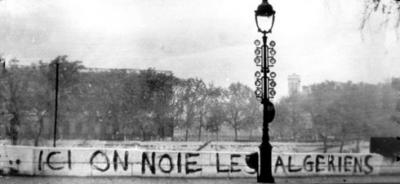
Paris: 1961 massacre of Algerians commemorated —and denied

Politicians, historians and others gathered in Paris Oct. 17 to mark the 50th anniversary of a police massacre of Algerian protesters that has become one of the most shameful episodes of modern French history. Although authorities still only acknowledge three deaths, estimates by historians and activists range from 50 to 300—many of the victims beaten and thrown into the river Seine.
In an unprecedented move by a French politician, newly named Socialist presidential candidate François Hollande officiated at the rally, and threw a single red rose into the Seine from the bridge at Clichy, the suburb where many of the victims lived. Afterwards he unveiled a plaque engraved with the words: "From this bridge and other bridges in the Paris region, Algerian demonstrators were thrown into the Seine on the 17 October 1961, victims of a blind repression. In their memory."
On the fateful day in 1961, some 30,000 Algerians—men, women and children—converged on Paris from the suburbs, to protest a curfew that had been imposed only on Algerians within the metropolitan area. The call to protest had also been issued by Algeria’s National Liberation Front, then fighting for independence from France, to oppose the French counter-insurgency campaign. They planned to rally at the famed Pace de l’Etoile, but as the marchers approached, police were ordered to halt their advance. The details of what happened next are still contested, as the police archives remain closed. A famous photo taken the next day shows a quay on the Seine scrawled with the graffito: "Here they drown Algerians."
The order for repression came from the prefect of Paris, Maurice Papon—a veteran of the Vichy regime who had collaborated in the deportation of Jews during the Nazi occupation. Papon was convicted of complicity in crimes against humanity in 1998, but his responsibility in the October 1961 massacre has been ignored—and remains buried in the hidden recesses of French state memory.
Algeria this year issued a stamp to commemorate the massacre. (The Guardian, AFP, Africa Report, PressEurop, Oct. 17)

